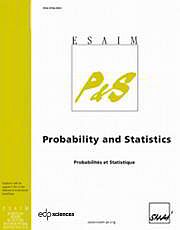Article contents
Data-driven penalty calibration: A case studyfor Gaussian mixture model selection
Published online by Cambridge University Press: 05 January 2012
Abstract
In the companion paper [C. Maugis and B. Michel,A non asymptotic penalized criterion for Gaussian mixture model selection. ESAIM: P&S15 (2011) 41–68] , a penalized likelihoodcriterion is proposed to select a Gaussian mixture model among aspecific model collection. This criterion depends on unknownconstants which have to be calibrated in practical situations. A“slope heuristics” method is described and experimented to dealwith this practical problem. In a model-based clustering context,the specific form of the considered Gaussian mixtures allows us todetect the noisy variables in order to improve the data clusteringand its interpretation. The behavior of our data-driven criterionis highlighted on simulated datasets, a curve clustering exampleand a genomics application.
Keywords
- Type
- Research Article
- Information
- ESAIM: Probability and Statistics , Volume 15: Supplement: In honor of Marc Yor , 2011 , pp. 320 - 339
- Copyright
- © EDP Sciences, SMAI, 2011
References
- 10
- Cited by


